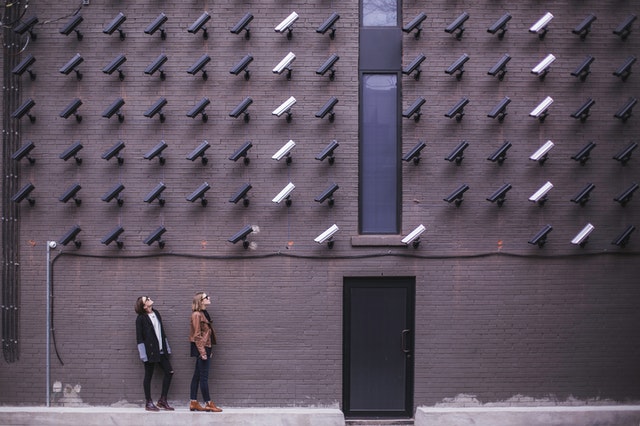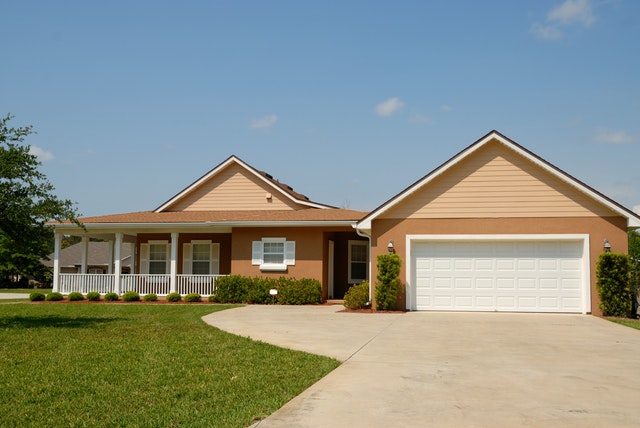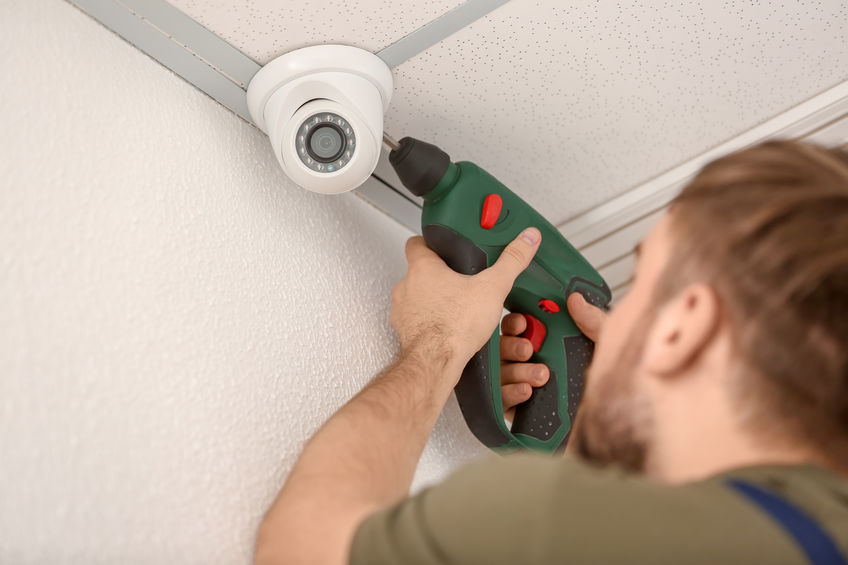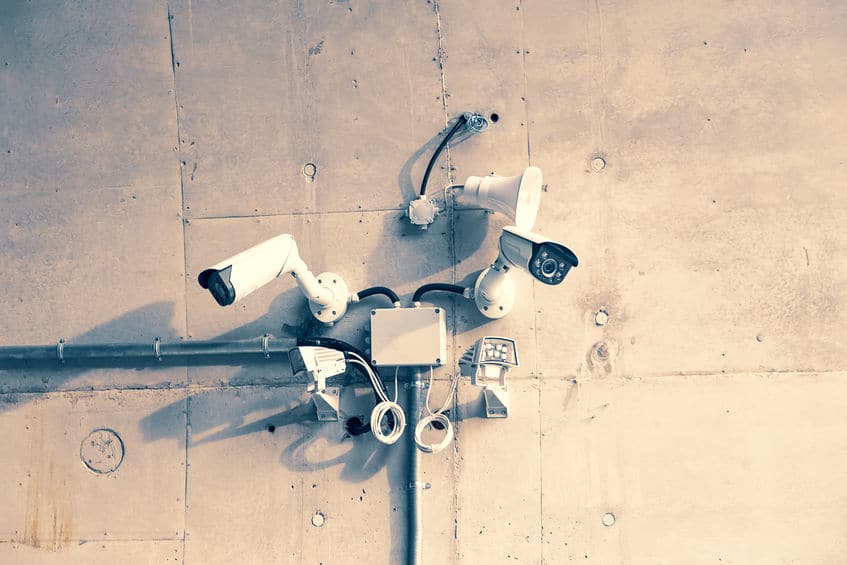We put up security cameras because we want our houses and properties to be protected, especially during times when we are away from home. However how many cameras do we need to put up to protect our homes?
Some say numbers do matter, while others say just a couple of cameras are enough to protect you and your family from burglars and other unwanted encounters.
Ideally, you should have at least three to four cameras on areas like the front door, front and back of the house and indoors such as the living room and/or the bedroom. You should also have cameras in your garage and backyard if you have one.
In this article, we will discuss how many security cameras are needed in your house.
We will also have a more detailed discussion with how many cameras are needed in specific parts of the house, such as the backyard or garage.
And we’ll also tackle the number of security cameras for small houses, big houses, apartments, and rental spaces.
The Ideal Number of Security Cameras at Home

The number of security cameras to be installed in your home vary from location to location, considering several factors as well.
At the end of the day, we just want our houses and properties to be protected, so knowing the perfect number is very important.
Spoiler: You Don’t Need a Bunch of Cameras
Each part of the house has specific requirements and functions. Not all parts require having security cameras unless it’s the Big Brother house, where a lot of cameras are needed for everyone’s surveillance.
Hence, it is not advisable to install a lot of cameras especially if you are in tight neighborhoods with little or no space. You also have to be strategic on where you put your security cameras, to avoid potential issues with your neighbors.
Important: Put The Security Cameras on These Parts
You should definitely put a camera on your front porch — this is for packages and people arriving at your doorstep. It is very important to see who approaches your house, be it your regular delivery guy from FedEx or your friendly neighbors trying to share some homemade pecan pie for the holidays.
Installing one on your front porch is important, especially at this time where everyone depends on deliveries and online purchases, seeing your visitors is important.
Put it on your front door, porch or doorstep, and/or the front garden or yard, whichever one you have. You also have to put one on the front and back parts of the house — for obvious purposes.
If it is indoors, you need to install one on places where a lot of people usually convene or go, specifically your working area or living room.
However, never put cameras on your bedroom to give you privacy, especially if you do personal stuff there such as sexual activities, or the simple act of taking your clothes off.
Remember that illegal capturing of videos of people, especially in their states of undress, are considered wiretapping and pornography.
These can be dealt with criminal cases, varying from state to state. Punishment for illegal recording of videos without the consent of those in the video will vary from state to state, but on a federal level, the Wiretap Act violators face $500 fine, five years imprisonment or both.
Factors You Need To Consider in Installing Cameras at Home
There are several factors that you need to look into in installing security cameras at home.
One is the size of your home. The bigger the home, the more cameras you will need. It goes without saying that outdoors will also have to have cameras installed. You should also consider the size of the property. Having a smaller lot or a smaller house means lesser cameras need to be installed, and vice versa.
Outbuildings also play a role in this project. If you have a shed or a workshop where you put valuable or expensive tools or equipment, or a barn for animals, or sheds outside, you should have more cameras installed, with the obvious reason of protecting your things inside.
You should also consider the camera type. You can use fewer cameras if you have high-quality cameras with wide-angle lenses with higher reach; otherwise, consider buying a lot more cameras.
Network’s bandwidth limit also matters, simply because wireless cameras rely on the network’s bandwidth for connectivity and recording. Make sure your Internet connection is consistent and can accommodate your security cameras for continuous functioning.
Purposes of Installing Security Cameras at Home
These are the reasons why we install security cameras at home:
One is to deter burglars or criminals from your home or property. Put higher quality security cameras around places where it requires more protection such as outside, your office, and other important areas.
Cameras are also used to capture imagery for evidence, especially if you have suspicious people with you, you can rely on security cameras in capturing images that can be helpful as evidence in case you need them for potential lawsuits.
We also use cameras to monitor your house while you’re away. Security cameras are needed because you have to be informed on what is happening inside and outside your house or property whenever you are away for business or other reasons.
Lastly, security cameras are used to alert you in case of suspicious activities — security cameras send alerts in real time once they detect movements in surveillance areas
Small Houses vs. Bigger Houses
The answer is obvious here, but we still need to find out where to place which cameras for maximum security protection on your end.
Put Cameras on The Essential Parts of Your House
As mentioned, put cameras on your front door, porch, yard, or lawn for security purposes, whichever is applicable. Put cameras on the hallways if you have a two-storey house for security.
If you have small children and/or babies with you, put cameras on their rooms so that you can check and monitor their activity while you are away or while you work away from them. The kitchen is also a vital point where accidents occur, so consider putting a couple there too.
Bigger Houses Require More Security Cameras

Obviously because of its size, more cameras are needed for bigger houses. Aside from the essential parts of the house, consider putting cameras outdoors such as the pool area, backyard, and the front lawn.
Cameras in pool areas are helpful especially if there are children loitering around or when drowning incidents occur.
Put cameras on your garage where your car is for protection of your vehicle. Put cameras on your shed or workshop if you have one, for your expensive tools and materials.
You should also put some around the yard for burglars and trespassers. Install one in your pet area as well, to monitor your pets especially while you are away or sleeping indoors.
Installing some in your office, if you have one, or other rooms where cash, jewelries, and other expensive items are stored, is also highly recommended.
Size Does Matter But Also The Rooms
The size of your house affects the number of cameras to be installed. Bigger houses need more protection so more cameras are needed to be installed.
Regardless, focus on the essential parts of the house where you need protection or monitoring. Buying high quality cameras can also help lessen the number since they perform better than the others.
Indoors vs. Outdoors — The Real Deal
Indoors and outdoors require different cameras for specific purposes. We have to find out which ones to install, and where to put them to maximize their purposes to the fullest of their abilities.
Outdoors Require More Security Cameras
The prime purpose of security cameras is to detect any unwanted or suspicious activity coming from the outside, such as burglars, trespassers, and gatecrashers. Naturally, more cameras are required outdoors, especially if you have a big yard or a garage, or both.
Put cameras on your front yard and backyard basically, then scatter them strategically to function even better. Buying cameras with higher reaches would be helpful since they can capture from afar.
Indoors Require Cameras on Specific Areas
Remember that we still need to have a sense of privacy and seclusion indoors. Unless you are in a reality show, install security cameras only on the important areas.
As much as possible, leave the bedroom and bathroom out because people do personal activities there such as taking a bath, doing personal businesses, and sexual activities.
If you have children, install on their rooms to monitor them especially while you’re outside the house or doing something downstairs.
If you’re enjoying this article then why not check out these related articles after finishing this one:
The Ultimate Guide to Recording CCTV Footage Across Different Platforms
How Long Do Motion Sensors Last – I Did The Research!
Should You Camouflage Security Cameras?
Dome Cameras vs Bullet Cameras – I Compared 10 – Here’s What I Found Out
Is It Legal for Security Cameras to Record Sound – US State Covered
Indoor Cameras vs. Outdoor Cameras: Differences

There are a lot of differences between indoor cameras and outdoor cameras. It depends on the type of external factors they have to be able to withstand while performing their duties. Such factors include types of weather, as well as the varying light conditions.
Outdoor cameras are more prone to tampering, that is why outdoor cameras are made of more durable materials such as metal. These can be heavier compared to ones used indoors.
Outdoor cameras may also be required to be put inside a casing for the protection of the camera itself. Some might dismantle the outdoor camera so casings are needed and highly recommended.
On the other hand, indoor cameras are smaller, lightweight, and usually less intrusive. Both types use infrared which enables them to take clear images regardless of lighting conditions. It also allows them to capture better images even if there are sudden changes in lighting.
That being said, dome cameras are perfect for indoors and outdoors. For outdoors, the dome structure gives an extra layer of protection. It is also designed to keep the onlooker from knowing the exact place where the security cameras are installed.
In addition, some outdoor cameras have blowers and heaters giving them another layer of protection against the elements outside. Hidden cameras better for indoor surveillance whilst CCTV cameras, which look more obvious, should be placed outside to intimidate criminals.
Use cameras with night vision for outdoors, and do not point cameras directly into the sun to avoid blocking. Avoid putting cameras in places that are too high, especially close to walkways and entrances.
Driveways vs. Backyards — The Real Deal
Both are outdoors, so one might think having an outdoor security camera would suffice. We need to know the key differences between these two and where to install cameras specifically on these two important parts of the house.
Put Cameras on Your Driveway And Garage
Obviously, putting cameras in your garage and also the driveway are needed. You need to see if your car is being protected from people who can bring harm and damage to it.
It can also be helpful when claiming insurance for car damage since you can provide evidence that your car was damaged in case of an accident captured on your CCTV.
Since the driveway is already outdoors, it can also provide a sense of security since it can capture activity from the outside.
Backyards Need Security Cameras Too

Not everyone has a car for a garage but some might have backyards. Installing cameras are helpful since they can also capture suspicious actions happening from the outside, before the criminals can enter your backyard.
If you also have outbuildings in your backyard or animals you need to take care of, installing cameras is a must. Pets need protection, too, so you can see whoever is trying to harm your dog at night if you have security cameras installed on where the pets can be seen.
Children also play in the backyard most of the time so installing cameras can be helpful.
Remember that one camera can capture a large area, but you may need more to help identify an intruder coming in from the backyard.
Important Things You Need to Remember
Burglars break into driveways and backyards most of the time. Sheds, driveways, backyards are also unoccupied most of the time. No one stays in the garage more often, we just go there when we need to use the car heading out and heading in the house.
Therefore, this gives them easy access to expensive items such as bikes, motorcycles and also potential weapons such as shovels, axes, pitchforks. Also, garages are dark places.
You have to point your security camera at an angle to your garage’s opening, not on the garage door to avoid lighting issues during daytime. A pro tip: put the camera at the entrance point to your backyard. Also, consider investing on multiple cameras for your backyard since it is a large area for you to monitor.
Putting Security Cameras on Apartments and Rental Places
You Can Put Cameras on Your Apartment
Good news: you are allowed to put security cameras on your apartment.
Most rental space owners put cameras primarily for the protection of its tenants or guests. There were issues surrounding security cameras and breaching personal privacy in rented areas so you cannot just put security cameras as discreetly as you would in your owned home.
You just have to coordinate with your landlord if you want to install more cameras on your unit. Also, check if laws or regulations regarding security cameras are in place and coordinate with authorities to avoid potential troubles.
Reasons Why It’s Okay To Install Security Cameras In Apartments
One of the reasons why we put security cameras in apartments is the protection of your assets and valuables. Since you share the building with multiple families, peoples with different personalities, and backgrounds, installing cameras is advisable to avoid having issues without basis between you and your neighbors.
Another is having a sense of security. Apartment complexes with security cameras are much sought after by tenants and seekers since they know their security will not be compromised. It is also because of higher potential rents or bookings, because for landlords and rental space owners, this is an asset.
Renters and tenants are much more willing to spend more for security cameras. This also reduces likelihood of break-ins in rental spaces.
Important Things to Remember in Installing Cameras
Laws about security cameras vary from state to state so check with your specific state’s laws before installing cameras. Remember that it is definitely illegal to install security cameras wherever people need privacy. Hence, stay out of bedrooms and bathrooms for privacy purposes.
Many states do not allow installation of security cameras inside their houses, so you should not install cameras inside. However, you can install cameras on your front and back door, driveway, garage, and backyard. Any “public” spaces can be monitored.
Cameras should be visible because it is illegal to install hidden or spy cameras on private property. Inform your landlord that security cameras will be installed, to avoid breaking laws. Choose a system that does not utilize audio recordings to avoid breaking any laws regarding wiretapping.
Install cameras without disturbing the peace of your neighbors. Excessive drilling through the walls is therefore not allowed. Ask for permission first when you install cameras in general.
Lastly, take them with you once you move out of your rental space to avoid complications. It is okay to install cameras as long as the installation does not cause damage to the building or to its tenants.
| How Many Security Cameras Should I Install At Home? | ||
| Indoors vs. Outdoors | Indoors: only put security cameras on important places such as the living room, offices, hallways, kitchens | Outdoors: put security cameras on your backyard, front porch, lawn, garage, garden, driveways, and sheds |
| Small Houses vs. Big Houses | Small houses: put security cameras on places where a lot of people convene such as the living room, dining room, front porch or front door | Big houses: put security cameras outdoors more than indoors; only put security cameras on important rooms indoors where jewelry or other expensive items are stored |
| Driveways vs. Backyards | Driveways: put the camera near the garage for your car’s protection | Backyards: put cameras by the pool area, sheds, pet houses, garden where children play |
| Apartments and Rental Spaces | Apartments: ask your landlord first for permission; then put cameras on your front door and the hallways; never put cameras indoors unless permitted by the landlord | Rental spaces: for landlords, inform tenants of the places where security cameras are installed in accordance to the laws, never put cameras where people can be seen in stages of undress |
Conclusion
We install security cameras to protect ourselves. We have to remember that we have to put cameras on the essential rooms and areas in your house, regardless of how big or small your house or property is.
Strategizing and buying the perfect cameras are also important to remember. If you are renting your house, ask for the permission of your landlord first and check the laws in your state regarding security cameras to avoid breaking laws surrounding it.
Be knowledgeable and you will have the safest days and nights with your security cameras.
If you’re enjoying this article then why not check out these related articles after finishing this one:
The Ultimate Guide to Recording CCTV Footage Across Different Platforms
How Long Do Motion Sensors Last – I Did The Research!
Should You Camouflage Security Cameras?
Dome Cameras vs Bullet Cameras – I Compared 10 – Here’s What I Found Out
Is It Legal for Security Cameras to Record Sound – US State Covered

